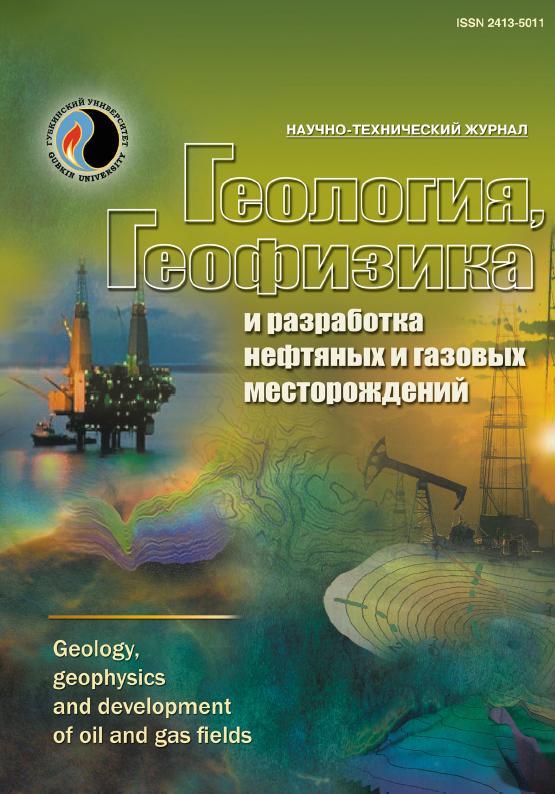Scientific and technical journal
«Geology, geophysics and development of oil and gas fields»
ISSN 2413-5011

. Study of geophysical cables thermal inertia. Determination of the heating time constant of fiber-optic distributed temperature sensors
UDC: 550.832
DOI: 10.33285/2413-5011-2023-7(379)-27-36
Authors:
1 PJSC "Permneftegeofizika", Perm, Russia
2 Perm State National Research University, Perm, Russia
Keywords: geophysical cable, long-term monitoring, calibration installation, optical fiber, transition processes, time constant, well
Annotation:
Based on a large number of experimental studies conducted with variously-designed geophysical cables samples, which include fiber-optic distributed temperature sensors, their inertial properties have been determined. To find the time constant of fiber-optic sensors, a Silixa fiber-optic station and a mobile thermally insulated calibration unit were used, heating and temperature control of the circulating liquid in which it was carried out using an electronic control unit. Quantification estimation of time constants values is a very important process, since the accuracy of temperature anomalies measurements directly depends on it, which can also be raised by increasing the discretization interval in depth and time. However, such an approach may eventually lead to a loss of informative value loss monitoring based on the registration of short-term transients anomalies. Manufacturers of geophysical cables with fiber-optic modules diverse properties do not determine the thermal inertia indicators, which forces them to be evaluated in production conditions. As a result of the research, an empirical equation was also obtained, which is one of the theoretical ways to determine the time constants of distributed fiber-optic temperature sensors integrated into cable designs with different geometries and materials.
Bibliography:
1. Agafonov D.S., Suleymanov R.I. Optimizatsiya tekhnologii paronagnetaniya pri razrabotke zalezhey vysokovyazkoy nefti // Sb. trudov Mezhdunar. nauch.-tekhnich. konf. – 2015. – № 3(309). – S. 139–151.
2. Buymistryuk G.Ya. Informatsionno-izmeritel’naya tekhnika i tekhnologiya na osnove volokonno-opticheskikh datchikov i sistem. – SPb.: GROTs Minatoma, 2005. – 191 s.
3. Bukhmirov V.V. Teplomassoobmen: ucheb. posobie. – Ivanovo: Ivanovskiy gos. energeticheskiy un-t imeni V.I. Lenina, 2014. – 360 s.
4. Vasil’ev A.N. Vozmozhnosti primeneniya novoy tekhnologii greyushchego kabelya dlya preduprezhdeniya obrazovaniya ASPO i VVE na mestorozhdeniyakh Udmurtii // Sb. tezisov X Mezhdunar. nauch.-praktich. konf. – Ufa: Izd-vo "Arkaim", 2015. – S. 3–9.
5. Vlasov A.I., Konyshev D.V., Korotkov I.V. Uchet postoyannoy vremeni nagreva pri razrabotke elektrostartera dlya zapuska gazoturbinnykh ustanovok // Elektronika i elektrooborudovanie transporta. – 2019. – № 1. – S. 20–23.
6. Dmitriev M. Kabel’nye linii 6 – 500 kV. Teplovoy raschet pri korotkom zamykanii // Novosti elektrotekhniki. – 2014. – № 5(89). – S. 52–55.
7. Ivlev V.I., Fomin N.E., Yudin V.A. Termicheskiy analiz. Ch. 1. Metody termicheskogo analiza: ucheb. posobie. – Saransk: Izd-vo Mordovskogo un-ta, 2017. – 44 s.
8. Isachenko V.P., Osipova V.A., Sukomel A.S. Teploperedacha. – M.: Izd-vo "Energiya", 1969. – 440 s.
9. Kabyshev A.V. Elektrosnabzhenie ob"ektov. Ch. 1. Raschet elektricheskikh nagruzok, nagrev provodnikov i elektrooborudovaniya: ucheb. posobie. – Tomsk: Izd-vo Tomskogo politekhnich. un-ta, 2007. – 185 s.
10. Primenenie optovolokonnykh sistem pri realizatsii kompleksnykh tekhnologiy zakanchivaniya i dolgovremennogo monitoringa raboty skvazhin / A.P. Laptev, A.D. Savich, V.I. Kostitsyn [i dr.] // Neft. khoz-vo. – 2022. – № 8. – S. 94–99.
11. Lapshina Yu.V., Rybka V.F. Rezul’tat primeneniya optovolokonnykh tekhnologiy raspredelennoy termometrii pri osvoenii skvazhiny s pomoshch’yu ETsN // Ekspozitsiya Neft’ Gaz. – 2013. – № 7(32). – S. 13–16.
12. Listvin A.V., Listvin V.N. Reflektometriya opticheskikh volokon. – M.: Izd-vo "LESARart", 2005. – 208 s.
13. Stend dlya kalibrovki raspredelennykh optovolokonnykh sistem kontrolya temperatury v polevykh usloviyakh / A.S. Petukhov, P.S. Lagunov, A.N. Nikonov, V.I. Luppov // NTV "Karotazhnik". – 2019. – № 5(299). – S. 106–119.
14. Razina A.P. Teplovaya inertsiya datchikov temperatury // Zhurnal "ISUP". – 2020. – № 2(86). – S. 15–17.
15. Khalilov D.G. Volokonno-opticheskaya sistema aktivnoy termometrii // NTV "Karotazhnik". – 2021. – № 3(309). – S. 139–151.
16. Aljawad M.S. Identifying Formation Mineralogy Composition in Acid Fracturing From Distributed Temperature Measurements // SPE Reservoir Evaluation & Engineering. – 2019. – Vol. 23(01). – Pp. 2022–211. – DOI: 10.2118/195537-PA
17. Tabatabaei Mohammad, Zhu Ding. Fracture Stimulation Diagnostics in Horizontal Wells Using DTS Data // SPE – Canadian Unconventional Resources Conference. – 2011. – DOI: 10.2118/148835-MS
18. RD 153-39.0-072-01: Tekhnicheskaya instruktsiya po provedeniyu geofizicheskikh issledovaniy i rabot priborami na kabele v neftyanykh i gazovykh skvazhinakh. – M., 2002. – 271 s.
19. URL:https://enteksys.ru/article-plotnost-teployomkost/
20. URL: http://interchim.ru/docs/polimery%20dlya%20kabeley/ME%206052.pdf
21. URL: https://learn.trudmore.ru/optika/osnovnye-xarakteristiki-opticheskogo-volokna/
22. URL: https://mplast.by/encyklopedia/polietilen-vyisokogo-davleniya-pevd/
23. URL: https://polymerbranch.com/catalogp/view/4.html&viewinfo=2
24. URL: https://silixa.com/heat-pulse-system-active-distributed-temperature-sensing/
25. URL: https://stankiexpert.ru/spravochnik/materialovedenie/stal-aisi-304.html
26. URL: https://studfile.net/preview/2893233/page:2/
28. URL: http://www.interlens.ru/gost3.html
29. URL: ttps://yandex.ru/search/?text=teploemkost’+plotnost’+bazal’t&lr=118359&clid=2486826&win=392